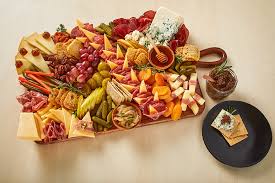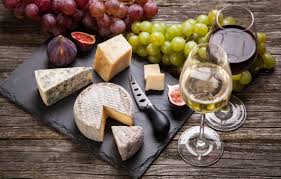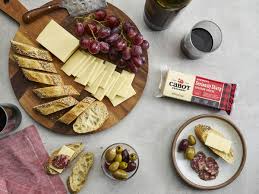- Homepage
- Information
- Exploring the Art of Cheese Pairing
Exploring the Art of Cheese Pairing
Cheese pairing is an age-old culinary tradition that brings out the best flavors in both cheese and its accompanying food or beverage. The practice is deeply rooted in regional cultures and traditions, making it an exciting and dynamic way to explore flavors. From wine and crackers to fruits and condiments, cheese pairing has evolved into a sophisticated art that requires a good understanding of textures, aromas, and tastes.
Understanding the Basics of Cheese Pairing
Contents
- 1 Understanding the Basics of Cheese Pairing
- 1.1 Flavor Balance
- 1.2 Texture Harmony
- 1.3 Popular Pairing Partners for Cheese
- 1.4 Creative Cheese Pairings with Beverages
- 1.5 Building the Perfect Cheese Board
- 1.6 Tips for a Memorable Cheese Pairing Experience
- 1.7 Exploring Regional Cheese Pairings
- 1.8 Embracing Seasonal Pairings
- 1.9 The Endless Possibilities of Cheese Pairing
- 2 Author

To master cheese pairing, it’s essential to understand the characteristics of different types of cheese. Cheese can be categorized into several families based on texture, flavor, and aroma, such as fresh, bloomy, washed rind, blue, semi-hard, and hard cheeses. Each type offers unique profiles that dictate the best pairings.
Flavor Balance
The core of successful cheese pairing lies in balancing flavors. For instance, a creamy and mild cheese like Brie pairs beautifully with something tangy or acidic, such as green apples or a glass of sparkling wine. On the other hand, a robust cheese like Roquefort benefits from a sweet companion, like honey or dessert wine, to balance its intense saltiness.
Texture Harmony
Texture plays a significant role in creating a delightful pairing experience. Hard and crumbly cheeses like Parmesan contrast well with smooth and velvety accompaniments such as olive oil or balsamic glaze. Meanwhile, soft cheeses like Camembert are complemented by crispy elements like crackers or toasted baguette slices.
Popular Pairing Partners for Cheese
Cheese pairing isn’t limited to wine, as many assume. A variety of foods and drinks can enhance the cheese experience.
Wine Pairing
Wine and cheese have been paired together for centuries. The general rule of thumb is to pair the intensity of the wine with the cheese. Bold, tannic red wines work well with aged cheeses like Gouda or Cheddar, while lighter white wines or sparkling wines are ideal for fresh cheeses like Mozzarella or Ricotta.
Fruit Pairing
Fruits bring natural sweetness and acidity that complement cheese’s richness. Fresh fruits like grapes, figs, and apples are classic choices. Dried fruits such as apricots and dates pair excellently with blue cheeses, creating a satisfying blend of sweet and savory.
Bread and Crackers
The neutral flavors of bread and crackers provide the perfect canvas for cheese. Artisan breads like sourdough or baguette slices add a rustic touch to cheese boards, while seeded crackers can offer additional flavor and crunch.
Nuts and Seeds
Nuts like almonds, walnuts, and pecans add a delightful crunch and earthy flavor to cheese pairings. Roasted or honey-glazed nuts are particularly delicious alongside creamy cheeses like Brie or goat cheese.
Condiments and Spreads
Honey, jams, and chutneys provide sweetness that contrasts beautifully with salty or tangy cheeses. For example, pairing a sharp blue cheese with a dollop of honey creates a balanced flavor profile. Mustards and savory chutneys also work well with harder cheeses like aged Cheddar.
Creative Cheese Pairings with Beverages

While wine is a traditional choice, other beverages can offer unique pairing experiences.
Beer
Beer and cheese pairing has gained popularity due to the variety of beer styles available. The carbonation in beer helps cleanse the palate, making it an excellent partner for rich and creamy cheeses. A stout pairs wonderfully with blue cheese, while a hoppy IPA complements sharp cheddars.
Tea
Tea offers a surprising and sophisticated pairing option for cheese lovers. The subtle flavors in tea allow the cheese’s character to shine. Green tea pairs well with fresh cheeses, while smoky black teas like Lapsang Souchong can match the intensity of aged cheeses.
Coffee
Coffee and cheese pairing is a newer trend that provides intriguing results. The bitterness of coffee balances the creaminess of cheeses like Mascarpone or Brie. For a bolder match, aged cheeses like Gouda can stand up to strong espresso.
Spirits and Cocktails
Spirits like whiskey and gin, as well as crafted cocktails, bring complexity to cheese pairings. The smoky and oaky notes of whiskey pair beautifully with hard cheeses like Parmesan, while a citrusy gin cocktail complements fresh cheeses like Ricotta.
Building the Perfect Cheese Board
Creating a well-rounded cheese board involves a thoughtful selection of cheeses and their pairings. Aim for a mix of textures, flavors, and milk types (cow, goat, sheep) to provide variety.
Choosing the Cheese
Include a balance of soft, semi-hard, and hard cheeses on your board. For example, pair a creamy Brie with a crumbly blue cheese and an aged Cheddar to offer contrasting textures and flavors.
Adding Accompaniments
Choose accompaniments that enhance the cheese without overpowering it. Fruits, nuts, crackers, and spreads should complement the cheese selection. A touch of garnish, such as fresh herbs or edible flowers, adds visual appeal.
Arranging the Board
Presentation is key to an inviting cheese board. Arrange the cheeses in separate sections and place accompaniments in between for easy access. Use small bowls for wet items like honey or jams to prevent mixing flavors.
Tips for a Memorable Cheese Pairing Experience

Creating a memorable cheese pairing experience involves more than just the right combinations. Here are some tips to elevate your next cheese-tasting event.
Serve Cheese at Room Temperature
Cheese tastes best when served at room temperature. Allow it to sit out for 30 to 60 minutes before serving to enhance its flavors and textures.
Use Proper Utensils
Provide a separate knife for each cheese to prevent flavor mixing. A cheese plane or spreader can be helpful for soft cheeses, while a sturdy knife is essential for hard cheeses.
Experiment with Pairings
Don’t be afraid to try unconventional pairings. Unexpected combinations, like pairing Brie with dark chocolate or Gouda with caramel, can yield delightful surprises.
Share the Story of the Cheese
Sharing the origin and characteristics of the cheeses on your board mancingduit can create a deeper appreciation for the flavors. Guests will enjoy learning about the unique aspects of each cheese.
Exploring Regional Cheese Pairings
Every region has its own cheese traditions and pairing preferences. Exploring these can broaden your palate and provide inspiration for your pairings.
French Pairings
France is renowned for its cheese culture. A classic pairing is Brie with Champagne, highlighting the creamy cheese’s richness with the bubbly wine’s crispness. Another favorite is Roquefort with Sauternes, a dessert wine that balances the blue cheese’s bold flavor.
Italian Pairings
Italy offers a wealth of cheese and pairing options. Parmesan pairs excellently with a drizzle of aged balsamic vinegar, while Mozzarella shines alongside fresh tomatoes and olive oil in a Caprese salad.
Spanish Pairings
Spain’s Manchego cheese is traditionally paired with quince paste, known as membrillo, for a sweet and savory experience. A glass of Tempranillo wine enhances the nuttiness of the cheese.
American Pairings
The United States has embraced artisanal cheese production, offering creative pairing opportunities. Aged Cheddar pairs beautifully with apple pie, showcasing the blend of sharp and sweet flavors.
Embracing Seasonal Pairings
Seasonal ingredients can inspire fresh and exciting pairings. In summer, pair cheeses with juicy berries and crisp rosé wines. During autumn, opt for aged cheeses with roasted nuts and spiced ciders. Winter calls for indulgent pairings like baked Brie with cranberry sauce, while spring is perfect for fresh goat cheese with vibrant herbs.
The Endless Possibilities of Cheese Pairing
Cheese pairing is an art that combines knowledge, creativity, and experimentation. Whether you’re a novice or a seasoned enthusiast, there’s always something new to discover in the world of cheese. With the right pairings, every bite becomes an exploration of flavors, textures, and aromas that elevate the cheese experience to new heights.


















